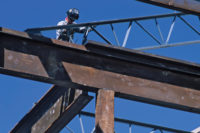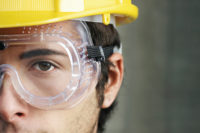
Ask a teenager what “hanging out” means, and he’ll probably tell you it’s simply sitting around with his friends doing not much of anything. But when it comes to working at heights, “hanging out” is a specific and dangerous position that threatens workers.
It’s lonely and dangerous to hang out alone, dangling from the side of a building in your harness after you’ve taken a fall on the job. You struggle to pull yourself up or to get a foothold anywhere. You can’t quite make it. Your buddies are trying, but they can’t reach you. Someone calls 911 and hollers that help is on the way. A few minutes pass. You begin to feel dizzy. You black out. What has happened?
Orthostatic intolerance
A fallen worker suspended in a harness must be rescued within five to ten minutes. If not, blood begins to pool in the legs, bringing on a condition known as orthostatic intolerance. Accumulation of blood in the legs due to the force of gravity and lack of movement reduces the blood in circulation. The body reacts; the heart rate increases in an effort to maintain an adequate flow of blood to the brain. However, this attempt fails when blood supply has been significantly reduced. The body abruptly slows the heart rate, reducing blood pressure in the arteries. If severe venous pooling occurs, the reduced oxygen supply to the brain results in fainting. The kidneys are sensitive to blood oxygen. Renal failure may occur.Following a fall, a worker may remain suspended in his harness. Immobility for a period of time will result in unconsciousness. At some point, the resulting orthostatic intolerance may result in death. Although uncommon, these fatalities are termed “harness-induced pathology” or “suspension trauma.” Would-be rescuers should look for the following symptoms of approaching orthostatic intolerance in the victim: faintness, dizziness, breathlessness, hot flashes, nausea and sweating.
Even after successfully retrieving the worker, care must be taken. Do not move him into a horizontal position. Doing so may cause too much deoxygenated blood to flow quickly to the heart. This sudden increase in blood flow may cause cardiac arrest.
Be prepared for rescue
OSHA’s Fall Protection Standard recognizes the potential danger to fallen workers. 29CFR Part 1926, Subpart M 502 (d) (20) reads, “The employer shall provide for prompt rescue of employees in the event of a fall or shall assure that employees are able to rescue themselves.”Some employers, fearful of causing further injury, have instructed workers not to attempt a rescue. If a fallen worker is unable to pull himself to safety, the protocol is: “Call for emergency responders and wait.” Given the dangers involved, wouldn’t it be prudent to train selected workers in appropriate rescue techniques?
New ANSI standard
ANSI Z359.1 addressed only “fall arrest systems.” The new ANSI standard Z359-2007 has been expanded to include five subsections. Although ANSI standards are voluntary and not themselves the law, they are recognized as good practice and are often adopted in OSHA regulations.ANSI Z359.2-2007 Minimum Requirements For A Comprehensive Managed Fall Protection Program: This subsection of the standard establishes guidelines and requirements for an employer’s fall protection program, including rescue procedures. It establishes roles and responsibilities for a “competent rescuer,” “authorized rescuer” and “competent rescue trainer.”
ANSI Z359.4-2007 Safety Requirements For Assisted Rescue And Self-Rescue Systems, Subsystems And Components: The purpose of this subsection is to provide requirements “for the performance, design, marking, qualification, instruction, training, use, maintenance and removal from service of equipment used in the assisted-rescue and self-rescue systems for one or two persons.” This equipment would include connectors, harnesses, lanyards, anchorage connectors, winches/hoists, descent control devices, rope tackle blocks and self-retracting lifelines with integral retrieval capability.
The capacity of the rescue system shall be from 130 lbs. (59kg) to 310 lbs. (140kg) for one person and 130 lbs. (59 kg) to 620 lbs. (280kg) for two-person systems. All connective hardware used shall comply with the requirements of ANSI Z359.1-2007.
System components
Section 3.2.2 “Body Support Components” details the requirements of the major components used in typical rescue systems.Full-body harnesses shall meet the requirements of ANSI Z359.1-2007. Unless prohibited by the manufacturer, the dorsal attachment element is suitable for rescue. Any other attachment elements designated for rescue must be statically tested to 3,600 lbs. Evacuation harnesses shall not be used for fall protection and shall at a minimum provide support for the body during rescue whether conscious or unconscious.
Rescue lanyards, anchorage connectors and self-retracting lanyards with rescue (RSRL) capability shall all meet the requirements of ANSI Z359.1-2007. In addition, the standard provides greater detail on the requirements for the RSRL, including:
• Ability to engage in rescue mode at any time and not inadvertently change to and from rescue mode;
• Minimum mechanical advantage of 3:1;
• Automatically stop and hold the load if the rescuer relinquishes control;
• Must have a means to stabilize the device during use in rescue mode;
• Devices that use a power source shall have a means to limit applied lifting force and speed and provide a manual backup means of operation.
Synthetic rope tackle block devices defined as, “a load lifting and/or lowering device that does not include a winding or traction drum but uses pulleys to achieve a mechanical lifting advantage” are detailed in Section 3.2.6. Among the highlights of the requirements are:
• Rope must be made of virgin synthetic material and have strength, aging, abrasion and heat resistance characteristics equal to or superior to polyamides and minimum breaking strength of not less than 4,500 lbs.;
• Have a secondary breaking means to prevent uncontrolled lowering of load;
• Have a minimum mechanical advantage of 3:1.


